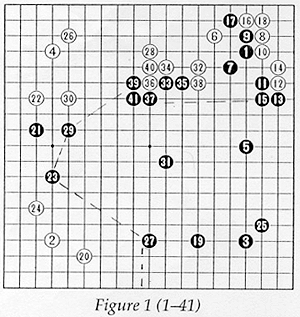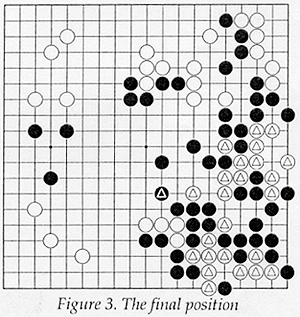Takemiya's cosmic go
Masaki Takemiya is one of the most popular go players in Japan. His ready smile and wry wit make his TV commentaries a pleasure to watch. Although his tournament successes have not been as stellar as Cho Chikun's and Koichi Kobayashi's, he has won his share of the big three titles--the Honinbo six times and the Meijin once.
What really captures the attention of his fellow professionals and go fans is his patented cosmic-go strategy. Most of the top players today place emphasis on securing territory early in the game. But not Takemiya. Instead, he maps out large spheres of influence in the center of the board, defying his opponents to invade. When they do invade, more often than not he succeeds in gaining more territory by attacking the invading stones. At times, his attacks are so fierce that he kills off the invaders, forcing his opponents to resign. In Game Two of the 1996 Meijin title match, he defeated Cho Chikun in exactly this way. I would like to show you this game as a typical example of Takemiya's cosmic-go style. Takemiya is Black.

In the skirmish up to White 18 in the upper right in Figure 1, Cho secures about eight points of territory, while Black begins to map out a huge sphere of influence on the right side. Cho then takes control of the areas in the lower right and upper left corners up to White 26, while Takemiya establishes a presence on the left side with Black 21, 23, and 29.
White 30 is a tight move that makes the territory in the upper left corner fairly secure. With Black 31, Takemiya boldly stakes out a claim to nearly a quarter of the board. Cho now has to play White 32 to prevent Takemiya from further expanding his influence in the top right.
Look at the position after Takemiya plays Black 41. He has laid claim to a vast valley of territory--"cosmic in scale"--in the center of the board as indicated by the dotted lines. If Cho doesn't invade or somehow reduce Takemiya's territorial framework, he will lose by a big margin.

When Cho pushes into Black's framework with White 42 in Figure 2, Takemiya falls back to Black 43. Takemiya has now mapped out more than 80 points of territory on right. If he can secure it with one more move, he will have more than enough to win. Therefore, Cho must invade. This he does by attaching the black stone with White 44. Cho struggles to make a living group with the sequence up to White 64, but Black 65 kills the white group in the bottom right. That is, it prevents White from making the shape that would enable his stones there to make two eyes.

When Takemiya played the triangled stone in Figure 3, Cho resigned because all of his stones (the marked white ones) in the lower right quadrant were dead. Black has more than 70 points there--far more territory than White.
